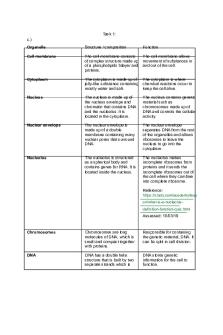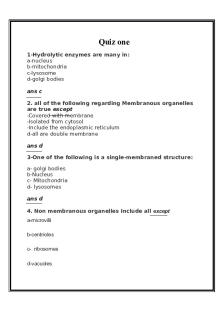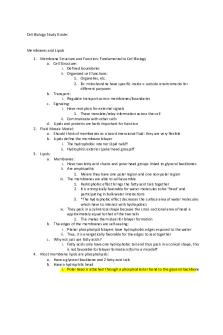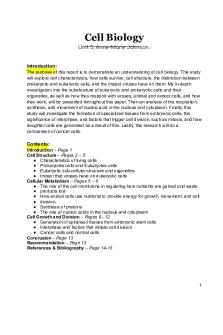Cell Biology Syllabus 2019 PDF

| Title | Cell Biology Syllabus 2019 |
|---|---|
| Author | mj fr |
| Course | Cell Biology |
| Institution | Rowan University |
| Pages | 5 |
| File Size | 245.8 KB |
| File Type | |
| Total Downloads | 89 |
| Total Views | 188 |
Summary
Download Cell Biology Syllabus 2019 PDF
Description
MBS00502 Cell Biology – Fall 2019 Credits: 3
Wednesdays, 5pm – 8pm Academic Center, Room 279
Course Director(s): Dmitriy Markov, Ph.D., Assistant Professor Dept. of Cell Biology and Neuroscience, RowanSOM Science Center, Room B206 856-566-6915 - office 856-566-6403 - lab [email protected] Office hours: Tuesday, 3pm-5pm or by appointment
Course Lecturer(s): Eric Moss, Ph.D., Associate Professor Dept. Molecular Biology, RowanSOM Science Center, Room B312 856-566-2896 [email protected]
Katharine Milani, Ph.D., Assistant Professor Dept. Molecular Biology, RowanSOM Science Center, Room B316 856-566-6041 [email protected]
Arnab Gosh, Ph.D., Postdoctoral Fellow Dept. of Cell Biology and Neuroscience, RowanSOM Science Center, Room B120 856-566-6907 [email protected] Venkat Venkataraman, Ph.D., Assistant Professor Dept. of Cell Biology and Neuroscience, RowanSOM Science Center, Room A220 856-566-6418 [email protected]
Course Description: This 3-credit didactic course focuses on fundamental principles of molecular and cell biology. It introduces molecular structures and biochemical processes which govern essential cellular functions and are coordinated through elaborate intracellular pathways and regulatory networks. The course is organized around the central themes of cell homeostasis – 1) how genetic information is preserved and released inside the cell and passed on to the daughter cells and essentially from generation to generation; 2) how cells meet a challenging demand to maintain their internal constancy necessary for all tissues and organs to function in ever-changing environmental conditions, and 3) how cell organelles and key biopolymers are affected by disease states.
Course Goal: The main goal of this course is to introduce Master students the key concepts of molecular and cell biology, including cell morphology, the structure and function of cellular organelles, modern aspects of The Central Dogma of molecular biology, and the major molecular biology pathways. It is a course for both the biomedical scientists who seek basic principles about cellular function, and the students preparing for health-related careers, who wish to apply their knowledge on cell physiology to understand the etiology of human diseases.
Learning Objectives: After completion of the course students are expected to…
Recognize essential cell biology terms Know structure and function of cellular organelles Understand basic molecular and biochemical pathways in cell physiology Be familiar with classical examples of how cellular metabolism changes in response to environmental stress and in disease state
Textbook(s): Essential Cell Biology, 5th Edition (ECB-5th) B. Alberts, K. Hopkin, A. Johnson, D. Morgan, M. Raff, K. Roberts, P. Walter. W. W. Norton & Company; July 1, 2019 ISBN-10: 0393680363 ISBN-13: 978-0393680362 ECB-5th is a core textbook for this course, on which the lecture material is essentially based on but not exclusively. Lectures may duplicate but also deviate from the textbook content. Students are required to purchase either hard copy or online E-version of the textbook: https://digital.wwnorton.com/ecb5. Students are expected to read the corresponding chapters of ECB-5th (indicated in the Course Schedule) prior each lecture and during preparation for the tests. Please note that all information necessary and sufficient to answer the exam questions will be given during the lectures in a form of oral presentations, PowerPoint or PDF slides, and/or handouts . There will be no exam questions that are based solely on the textbook material and were not explained during lectures.
Attendance Policy: Attendance is not enforced or monitored on a regular basis but is strongly encouraged and highly anticipated.
Homework Policy: 1) Students are expected to be familiar with the corresponding chapter(s) from ECB-5th textbook prior each lecture (chapters are indicated in the Course Schedule below). 2) Also, after each lecture, the students will have to take Blackboard pre-assessment test (quiz) containing 10 questions that cover the later lecture material and the textbook chapter(s) for the following lecture. Preassessment tests are intended to facilitate independent learning, and to give students an idea about their learning pace and capabilities before they take the full exam (please see the Exam and Grading Policy sections of the current syllabus). The quiz will be posted on the same day after the lecture, before midnight, and students should complete the quiz within a week, by 12 pm next Wednesday. During this time window, there will be only one attempt given to take the quiz. The quiz should be completed in one sitting, and the duration of test will be limited to 30 minutes. The format of questions will be similar to the course exams (see Exam Policy below). Students are expected to take the pre-assessment tests independently. It is the students’ responsibility to make sure that, while they are taking the quiz, the internet connection is reliable. After the quiz is completed, each student will be able to see the individual score, and which questions they answered correctly/incorrectly. The full explanation for correct answers and the answers’ text will be available to the students only after the quiz deadline. Completion of the quizzes (total of 12) is mandatory and will account for 6% of the students’ final % score (each missing quiz/deadline will result in the deduction of 0.5% from the final cumulative score, and each incorrectly answered question will result in 0.05% deduction, respectively; please also see the Grading Policy section).
Exam Policy: Three comprehensive exams will be given during the course in a form of ExamSoft-based, 3-hour noncumulative tests, during which the students will be required to answer short multiple-choice questions by choosing only one best answer that is deemed to be correct. Please note that incorrect choices may also contain information that answers the question partly or be relevant to the topic presented in the question. Possible question formats may also include (but not limited to) matching and fill-in questions, choosing correct or incorrect statements, and may be supplemented by illustrations. All information necessary and sufficient to answer the exam questions will be given during the lectures in a form of oral presentations, PowerPoint or PDF slides, and/or handouts. While each non-cumulative exam aims to cover material from 4 preceding lectures only, it may also require knowledge of the material from any of the previous lectures. Each 3 hour lecture will be covered by approximately 20 questions on the test, making a total of about 60 questions per test (see the Grading Policy below). In addition to those questions, 5 extra questions will be administered to offset possible exam errors, and after the exam, 5 questions with the lowest % of students who answered them correctly will be removed from the consideration, including those that contain errors, thus leaving only 60, 62, and 66 questions to be scored after the first, the second, and the third exam, respectively.
Please arrive to the exam at least 15 minutes before the test so that there will be enough time to download the test software on your computer. Importantly, please do not bring any study material to the test and do not open any lecture files or handouts on your computer in the exam room. During the exam, no questions to the attending faculty or proctors regarding the questions’ content are allowed except for the technical, software and organizational issues/problems. All students’ questions and concerns regarding the exam questions may be addressed to the Course Director or the lecturer by e-mail after the test and may be brought up at the exam review that will be conducted shortly after the test. The exam reviews are scheduled off lecture hours, normally during the Course Director’s office hours. There will be no remediation exams for this course or separate, additional assignments that are intended to offset low performance on the scheduled exams, so please take preparation for each test very seriously. The students who are unable to attend the exam due to an emergency reason have to notify the Course Director and may reschedule the exam in accordance to Rowan GSBS Policy by contacting the Program Director (Dr. Moss, [email protected]). The Course Director reserves a right to amend the exam questions and change the grades’ distribution if errors in the questions are revealed upon the exam review.
Grading Policy: The final % scores for the course will be calculated from the weighted inputs of each test as % of correctly answered questions: Exam I Exam II Exam III Pre-assessment quizzes completion Total:
30% of the final score (60 questions are counted toward % score) 31% (62 questions are counted toward % score) 33% (66 questions are counted toward % score) 6% 100%
Each incorrectly answered question on the exam accounts for 0.5% deduction from the maximum, 100% score. Each incorrectly answered question in the home quiz accounts for 0.05% deduction. The final % score will be calculated as a direct input of correctly answered questions as follows: The final % score = number of correct answers on the exams ÷ 2 + number of correct answers from the quizzes ÷ 20 The final, letter grades for this course will be “curved”. The curve will be based upon the ‘anchoring to the mean’ in which the average percentage score rounded to the whole number will be equal to a center of 3.0 (B) range on the 4 point GPA scale in accordance to Rowan GSBS Grading Policy as follows: A AB+ B BC+ C CD+ D DF
4.0 3.7 3.3 3.0 2.7 2.3 2.0 1.7 1.3 1.0 0.7 0.0
The letter grade will have a 10% range except ‘A’, including 4% allocated for the whole grade, and 3% allocated for each partial (+ or -) grade. EXAMPLE: if, hypothetically, after all exams, the mean happens to be 80%, ‘B’ grade will be given to those who scored 79-82% after all three exams and quizzes, then ‘B-‘ will be given to those who scored 76-78%, ‘C+’ - to those who scored ’73-75%, ‘C’ – to those who scored 69-72%, etc.; ‘B+’ - to those who scored 83-85%, ‘A-‘ to those who scored 86-88%, and ‘A’ to those who scored 89% and above. A course evaluation will be administered by GSBS office at the end of the course.
Course Schedule: Week
Date
1
Sept. 11
2
Topic
Lecturer
Chapters
Introducing cell as a fundamental unit of life. Analyzing and visualizing cells. Prokaryotes and eukaryotes. Animal and plant cells.
Markov
ECB-5th: Ch. 1 pp.2-38 (38 pages)
Sept. 18
Chemical components of the cell. Atoms, molecules and chemical bonds. Carbon chains and their functional groups. Major classes of biomolecules. Mono - and polysaccharides.
Markov
ECB-5th: Ch. 2 pp.39-80 (42 pages)
3
Sept. 25
Protein structure and function. Polypeptide chains. Major protein folds, conformations, modifications and cofactors.
Markov
ECB-5th: Ch. 4 pp.117-172 (49 pages)
4
Oct. 2
Lipids, lipid bilayer and membrane structure. Membrane proteins and transport. Electrical properties of membranes. Resting and action potentials.
Markov
ECB-5th: Ch. 11,12 pp.365-425 (59 pages)
5
Oct. 9
Exam I
6
Oct. 16
Nucleic acids. DNA and chromosomes. Chromatin structure. DNA replication, repair, and recombination.
Ghosh
ECB-5th: Ch. 5,6 pp. 173-226 (51 pages)
7
Oct. 23
Gene expression and basic genetic mechanisms. The Central Dogma of molecular biology and associated processes. Regulation of gene expression.
Ghosh
ECB-5th: Ch. 7,8 pp. 227-295 (64 pages)
8
Oct. 30
Intracellular organelles and compartments. Membrane trafficking and protein sorting.
Markov
ECB-5th: Ch. 15 pp.495-531 (36 pages)
9
Nov. 6
Cell signaling. Receptors, signal transduction pathways and secondary messengers. G-protein-coupled receptors.
Venkataraman
ECB-5th: Ch. 16 pp.533-572 (39 pages)
10
Nov. 13
Exam II
11
Nov. 20
Cytoskeleton. Actin and intermediate filaments. Microtubules. Muscle contraction.
Milani
ECB-5th: Ch. 17 pp. 573-608 (36 pages)
12
Nov. 27
Cell division. Overview of the cell cycle. Sexual reproduction. Mitosis, meiosis and fertilization.
Markov
ECB-5th: Ch. 18 pp. 609-639 ECB-5th: Ch. 19 pp. 651-663 (41 pages)
13
Dec. 4
Cell connectors. Extracellular matrix and cell junctions. Main tissues types.
Milani
ECB-5th: Ch. 20, pp. 691-709 (17 pages)
14
Dec. 11
Tissue maintenance and renewal. Stem cells. Apoptosis. Cancer.
Moss
ECB-5th: Ch. 18 pp. 639-649 ECB-5th: Ch. 20, pp. 709-734 (34 pages)
15
Dec. 18
Exam III...
Similar Free PDFs

Cell Biology Syllabus 2019
- 5 Pages

Biology Syllabus 2018-2019
- 1 Pages

Cell Bio Syllabus Fall 2019
- 3 Pages

Cell biology
- 3 Pages

Cell Biology Quiz CELL ORGANELLES
- 10 Pages

Cell Biology Study Guide
- 37 Pages

Cell Biology unit (5)
- 14 Pages

Apoptosis - Summary Cell Biology
- 4 Pages

Cell biology exam, answers
- 11 Pages

Cell biology lecture notes
- 108 Pages

Adam\'s Cell Biology- Exocytosis
- 4 Pages

Cell biology and genetics
- 12 Pages

Cell biology revision notes
- 5 Pages

Unit 5 Cell Biology
- 18 Pages
Popular Institutions
- Tinajero National High School - Annex
- Politeknik Caltex Riau
- Yokohama City University
- SGT University
- University of Al-Qadisiyah
- Divine Word College of Vigan
- Techniek College Rotterdam
- Universidade de Santiago
- Universiti Teknologi MARA Cawangan Johor Kampus Pasir Gudang
- Poltekkes Kemenkes Yogyakarta
- Baguio City National High School
- Colegio san marcos
- preparatoria uno
- Centro de Bachillerato Tecnológico Industrial y de Servicios No. 107
- Dalian Maritime University
- Quang Trung Secondary School
- Colegio Tecnológico en Informática
- Corporación Regional de Educación Superior
- Grupo CEDVA
- Dar Al Uloom University
- Centro de Estudios Preuniversitarios de la Universidad Nacional de Ingeniería
- 上智大学
- Aakash International School, Nuna Majara
- San Felipe Neri Catholic School
- Kang Chiao International School - New Taipei City
- Misamis Occidental National High School
- Institución Educativa Escuela Normal Juan Ladrilleros
- Kolehiyo ng Pantukan
- Batanes State College
- Instituto Continental
- Sekolah Menengah Kejuruan Kesehatan Kaltara (Tarakan)
- Colegio de La Inmaculada Concepcion - Cebu

